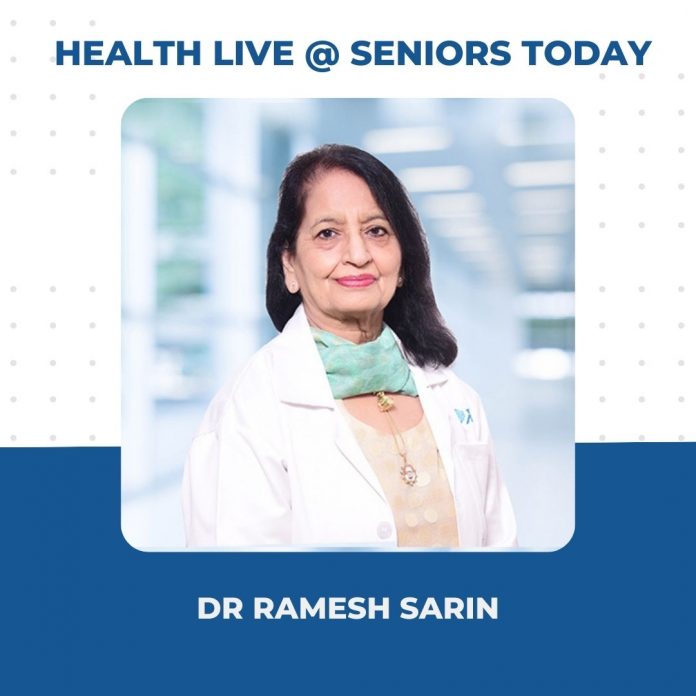On Feb 26, 2022 Seniors Today hosted its weekly Health Live Webinar on a very eminent and noteworthy topic with Dr Ramesh Sarin who is a Senior Consultant Surgical Oncology, Apollo Cancer Centres and the topic for discussion was Breast Cancer & Cancer Care for Seniors
A little about Dr Ramesh Sarin
Dr Ramesh Sarin is a Senior Consultant Surgical Oncology at Apollo Cancer Centres, New Delhi specialising in Breast Oncology. Her areas of specialisation include Breast Conservative Surgery with Oncoplasty, Sentinel Lymph Node Biopsy in both Pre & Post Neo-Adjuvant Chemotherapy, Breast Reconstruction and Benign Breast Diseases
The bad news is- anybody can get breast cancer.
The good news is- if detected early, it can be treated and cured.
Risk factors for breast cancer:-
- Family history
- Age- women above the age of 50 are at a higher risk
- Women who had their children after the age of 30 or women who never had children. Women who haven’t breastfed their children have a higher chance of getting breast cancer.
- If you hit menarche (the onset of the menstrual cycle) before the age of 12 or if you achieved menopause after the age of 54 years of age or if you’ve taken post menopausal hormone therapy
- Research has also shown links with diet, physical inactivity and obesity.
What is more worrying is, most of the women who develop breast cancer do not have any of these risk factors.
One out of every 25 woman in the world will develop breast cancer.
How to self examine your breasts:
Observe- stand in front of a mirror have a look at the size and shape of both the breasts. If you notice any changes, consult your doctor immediately.
Note: it is not unusual for one breast to be larger than the other.
Look for any puckering, dimpling or any other changes in the skin
See if there is any change in the position of either nipples
Also look for any retraction from the nipples or discharge from the nipples.
If you have large breasts, lift them up slightly to examine underneath.
Raise your arms over your head and look for similar skin and nipple changes.
Continue the examination with your arms clasped behind your neck with you tightening your neck muscles.
Finally place down your hands on your hips, press down and look again for any changes in your nipples and skin
Feeling the breasts- lie down and place a folded towel under your shoulder on the side you’re going to examine first. Raise your arm under which you’ve placed the towel.
The area you will be examining will involve not only the breasts but also the area above, till the collar bone, across and over to your armpit.
Using the pads of your first 3 fingers, begin to examine your breast using a series of small circular motions each about the size of a rupee coin.
You should use 3 levels of pressure- light, medium and heavy.
Trace a series of vertical strips moving from the collar bone to below the breasts and then back up again in zigzag motion. You can also use a technique where you trace a series of concentric circles towards the nipple. It is important to cover the entire breast.
Squeeze the nipple to see if there is any discharge. If there is any, it is advised that you see a doctor.
Repeat the same on the opposite side
- Self examination needs to be done regularly after the age of 20
- After the age of 30, in addition to the self examination, you also need to get a clinical examination done by a doctor.
A self exam, once a month and a clinical exam once a year.
- After the age of 40, the women have to be extra careful and that is when you need a regular mammogram with your rising age and risk.
A mammogram is an X-ray of the breast. A mammogram can pick up a tumour much before it is felt. It also shows few deposits of calcium. These mammograms must be interpreted by a trained radiologists
A mammogram is a painless procedure, some women might complain of some discomfort but none complain of acute pain.
It is advisable to get your mammogram a few days after your periods.
The risk from the radiation of a mammogram is negligible
The risks associated to an annual mammogram are far less than the benefits
An FNAC (Fine Needle Aspiration Cytology) or a needle biopsy can also be done.
Breast cancer is one of the most curable forms of cancer. With the recent medical advancements, the cure rate is 90% and the treatment is quite patient friendly.
You can reduce your risk for developing breast cancer by improving your lifestyle:
- By maintaining a normal weight
- Eating a healthy diet
- Regular exercise
Some risk factors are
- Obesity
- A diet rich in fats
- Sitting around with no exercise/ physical activity
- Junk food
If possible, women should marry and have a child before the age of 30
Research has suggested that you can find some preventative properties in plants. You can find them in carrot, yellow and orange fruit, tomatoes, watermelon, green and black tea, flax seeds, guava, cabbage, cauliflower.
Breast cancer can happen to men but the incidence and the rate is only 1% of the females.
That is why it is advised to men to also check their breast while showering.
A mammogram is not advisable for men since it is not cost effective.



